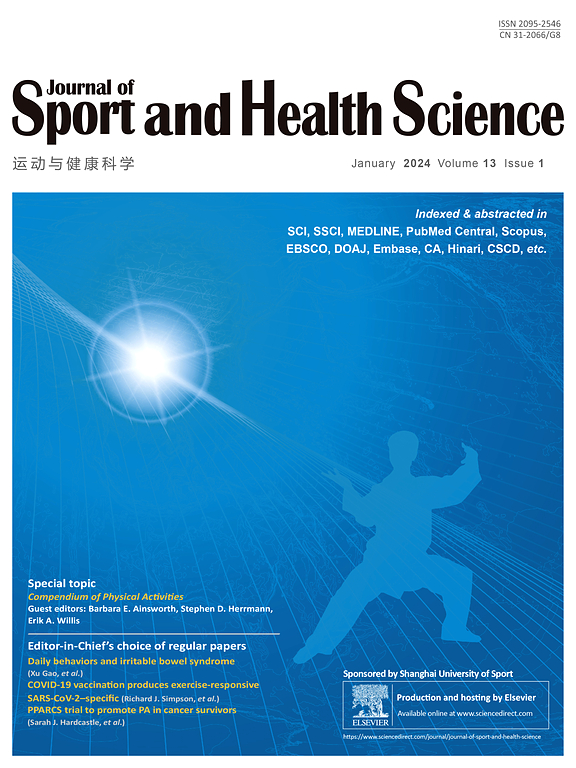2型糖尿病患者1年强化生活方式干预后6年血糖控制和心血管危险因素随访:随机u型大转弯试验的延伸
IF 10.3
1区 医学
Q1 HOSPITALITY, LEISURE, SPORT & TOURISM
引用次数: 0
摘要
目的:本研究旨在描述1年生活方式干预对2型糖尿病(T2D)患者停止生活方式干预5年后血红蛋白A1c (HbA1c)和心血管危险因素的影响。方法2015年4月至2016年8月,98例T2D患者(病程< 10年)随机(2:1,按性别分层)分为1年生活方式干预组(INT) (n = 64)和标准治疗组(StC) (n = 34)。所有参与者都接受了标准的盲法、靶标驱动的药物治疗。INT包括每周5-6次有监督的有氧和力量训练课程,以及针对体重指数≤25 kg/m²的饮食计划。随访期间未进行干预。49名(77%)INT和19名(56%)StC参与者参加了为期6年的随访。基于初始意向治疗人群,主要结局是HbA1c从基线到6年随访的变化。次要结局包括体重、低密度脂蛋白(LDL)胆固醇、血压(BP)和心肺健康。结果98例,平均年龄54.6岁;46%的女性;平均基线血红蛋白A1c (HbA1c): 49.8 mmol/mol。从基线到6年随访,INT和StC患者的HbA1c变化了6%和13%(组间差异:-6% (95%CI: -14至3); = 0.18页)。虽然在大多数次要结果中没有观察到差异,但与INT相比,StC组舒张压下降6.0 mmHg (95%CI: 2.1至9.8)。结论生活方式干预对血糖控制和心血管危险因素的持续影响是边际的,并且与舒张压调节有关。本文章由计算机程序翻译,如有差异,请以英文原文为准。
Six-year follow-up of glycemic control and cardiovascular risk factors after a one-year intensive lifestyle intervention in type 2 diabetes: An extension of the randomized U-TURN trial.
PURPOSE
This study aimed to describe the effects of a 1-year lifestyle intervention on hemoglobin A1c (HbA1c) and cardiovascular risk factors 5 years after cessation of the lifestyle intervention in persons with type 2 diabetes (T2D).
METHODS
From April 2015 to August 2016, 98 persons with T2D (duration < 10 years) were randomly allocated (2:1, stratified by sex) to a 1-year lifestyle intervention group (INT) (n = 64) or a standard care group (StC) (n = 34). All participants received standard care with blinded, target-driven medical therapy. INT included up to 5-6 weekly supervised aerobic and strength training sessions and dietary plans targeting a body mass index ≤ 25 kg/m². No intervention was given during the follow-up period. Forty-nine (77%) and 19 (56%) participants in INT and StC attended the 6-year follow-up. Based on the original intention-to-treat population, the primary outcome was the change in HbA1c from baseline to 6-year follow-up. Secondary outcomes included weight, Low density lipoprotein (LDL) cholesterol, blood pressure (BP), and cardiorespiratory fitness.
RESULTS
Ninety-eight participants (mean age 54.6 years; 46% women; mean baseline Hemoglobin A1c (HbA1c): 49.8 mmol/mol) were analyzed. HbA1c changed 6% and 13% in the INT and StC from baseline to 6-year follow-up (between group difference: -6% (95%CI: -14 to 3); p = 0.18). While no differences were observed for most secondary outcomes, the diastolic BP decreased 6.0 (95%CI: 2.1 to 9.8) mmHg more in the StC compared to INT.
CONCLUSION
The sustained effect of the lifestyle intervention on glycemic control and cardiovascular risk factors was marginal, and it was surprisingly associated with inferior diastolic BP regulation.
求助全文
通过发布文献求助,成功后即可免费获取论文全文。
去求助
来源期刊

Journal of Sport and Health Science
SPORT SCIENCES-
CiteScore
18.30
自引率
1.70%
发文量
101
审稿时长
22 weeks
期刊介绍:
The Journal of Sport and Health Science (JSHS) is an international, multidisciplinary journal that aims to advance the fields of sport, exercise, physical activity, and health sciences. Published by Elsevier B.V. on behalf of Shanghai University of Sport, JSHS is dedicated to promoting original and impactful research, as well as topical reviews, editorials, opinions, and commentary papers.
With a focus on physical and mental health, injury and disease prevention, traditional Chinese exercise, and human performance, JSHS offers a platform for scholars and researchers to share their findings and contribute to the advancement of these fields. Our journal is peer-reviewed, ensuring that all published works meet the highest academic standards.
Supported by a carefully selected international editorial board, JSHS upholds impeccable integrity and provides an efficient publication platform. We invite submissions from scholars and researchers worldwide, and we are committed to disseminating insightful and influential research in the field of sport and health science.
 求助内容:
求助内容: 应助结果提醒方式:
应助结果提醒方式:


